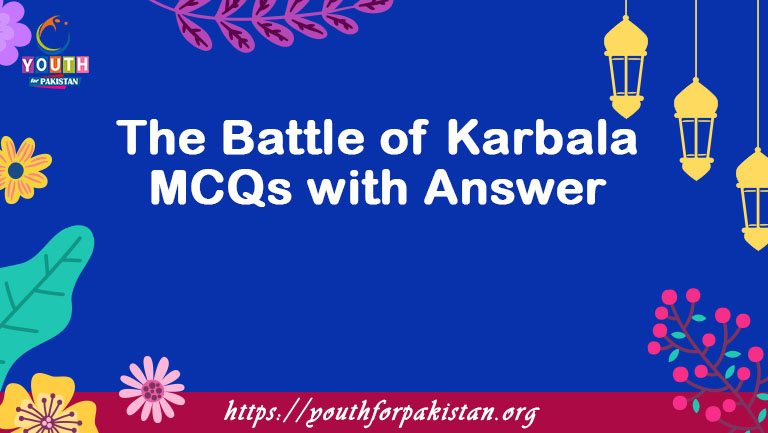The following are The Battle of Karbala MCQs with answers related to Islamic Studies. We have arranged the most important and repeated MCQs in all the competitive examinations. The students can clear their concepts for The Battle of Karbala MCQs online quiz by attempting these.
The Battle of Karbala Online MCQs with Answers
Which Islamic figure played a central role in the Battle of Karbala?
a) Caliph Ali
b) Caliph Umar
c) Imam Hussain
d) Imam Hasan
In which century did the Battle of Karbala take place?
a) 6th century
b) 7th century
c) 8th century
d) 9th century
What was the primary cause of the Battle of Karbala?
a) Territorial disputes
b) Religious differences
c) Economic rivalry
d) Dynastic succession
The Battle of Karbala is a significant event in which branch of Islam?
a) Sunni
b) Shia
c) Sufi
d) Ibadi
Who was the leader of the Umayyad forces in the Battle of Karbala?
a) Caliph Ali
b) Imam Hussain
c) Caliph Yazid
d) Imam Hasan
What is the primary religious significance of the Battle of Karbala for Shia Muslims?
a) It marks the birth of Imam Hussain.
b) It commemorates the martyrdom of Imam Ali.
c) It symbolizes the struggle for justice and truth.
d) It signifies the end of the Islamic caliphate.
What was the outcome of the Battle of Karbala for Imam Hussain and his followers?
a) Victory and establishment of a new caliphate
b) Defeat and martyrdom of Imam Hussain and his supporters
c) Surrender and exile to Medina
d) Capture and imprisonment of Imam Hussain
Who was the governor of Kufa at the time of the Battle of Karbala?
a) Caliph Ali
b) Caliph Umar
c) Ubaydullah ibn Ziyad
d) Imam Hussain
Which river was located near the battlefield of Karbala?
a) Tigris River
b) Euphrates River
c) Nile River
d) Jordan River
What is the religious significance of the Battle of Karbala for Sunni Muslims?
a) It marks the birth of the Prophet Muhammad.
b) It commemorates the martyrdom of Imam Hussain.
c) It symbolizes the struggle for justice and truth.
d) It signifies the end of the Islamic caliphate.
Who was the eldest son of Imam Hussain who was also martyred at the Battle of Karbala?
a) Ali Zayn al-Abidin
b) Ali ibn Abi Talib
c) Ali al-Akbar
d) Ali al-Asghar
What is the name of the shrine built at the site of the Battle of Karbala to commemorate the martyrs?
a) Al-Masjid al-Haram
b) Al-Masjid al-Nabawi
c) Al-Masjid al-Aqsa
d) Imam Hussain Shrine
What role did the Euphrates River play in the Battle of Karbala?
a) It served as a natural barrier protecting one side.
b) It was a source of drinking water for both armies.
c) It facilitated the movement of troops during the battle.
d) It had no significant role in the battle.
Which Islamic scholar and historian is known for his comprehensive account of the Battle of Karbala?
a) Ibn Khaldun
b) Ibn Taymiyyah
c) Al-Tabari
d) Ibn Kathir
What was the role of Hazrat Abbas ibn Ali in the Battle of Karbala?
a) He was the commander of the Umayyad forces.
b) He led the prayer for Imam Hussain’s followers.
c) He played a key role in securing water for Imam Hussain’s camp.
d) He was a prominent diplomat during the conflict.
Which city served as the starting point of Imam Hussain’s journey to Karbala?
a) Mecca
b) Medina
c) Kufa
d) Damascus
How did the Battle of Karbala impact the historical trajectory of Islam?
a) It marked the beginning of the Umayyad dynasty.
b) It had no impact on the historical trajectory of Islam.
c) It contributed to the development of Shia Islam.
d) It led to the unification of Sunni and Shia Muslims.
What was the role of the Karbala region in the Battle of Karbala?
a) It was a neutral territory where the battle took place.
b) It was the capital of the Umayyad Caliphate.
c) It was the birthplace of Imam Hussain.
d) It had no direct role in the battle.
Who is considered the third Shia Imam and a key figure in the Battle of Karbala?
a) Imam Ali
b) Imam Hassan
c) Imam Hussain
d) Imam Mahdi
What was the primary reason for the martyrdom of Imam Hussain and his followers in the Battle of Karbala?
a) They refused to pledge allegiance to the Umayyad Caliph.
b) They sought revenge against the Kufan governor.
c) They were defending their territory from an invasion.
d) They were engaged in a territorial dispute.
Who was the commander of the Umayyad forces that fought against Imam Hussain in the Battle of Karbala?
a) Caliph Ali
b) Imam Hussain
c) Caliph Yazid
d) Umar ibn Sa’ad
What is the name of the flagbearer of Imam Hussain during the Battle of Karbala, known for his unwavering loyalty?
a) Hazrat Abbas
b) Hazrat Ali
c) Hazrat Umar
d) Hazrat Hasan
How did the Battle of Karbala impact the religious beliefs and practices of Shia Muslims?
a) It had no impact on Shia religious beliefs.
b) It reinforced the concept of Imamate in Shia Islam.
c) It led to the rejection of the concept of Imamate.
d) It resulted in the conversion of Shia Muslims to Sunni Islam.
Which member of the Prophet Muhammad’s family was among the martyrs at the Battle of Karbala?
a) Fatimah bint Muhammad
b) Ali ibn Abi Talib
c) Hasan ibn Ali
d) Abbas ibn Ali
What is the name of the river near which Imam Hussain’s camp was located during the Battle of Karbala?
a) Tigris River
b) Euphrates River
c) Nile River
d) Jordan River
How many companions and family members were martyred alongside Imam Hussain at the Battle of Karbala?
a) 10
b) 50
c) 72
d) 100
What is the primary religious commemoration associated with the Battle of Karbala among Shia Muslims?
a) Ramadan
b) Ashura
c) Eid al-Fitr
d) Hajj
Who is the fourth Shia Imam known for his supplications and sermons during and after the Battle of Karbala?
a) Imam Ali
b) Imam Hussain
c) Imam Sajjad
d) Imam Mahdi
How did the outcome of the Battle of Karbala affect the Umayyad Caliphate?
a) It led to the fall of the Umayyad dynasty.
b) It consolidated the power of the Umayyad Caliphate.
c) It had no impact on the Umayyad Caliphate.
d) It resulted in the establishment of the Abbasid Caliphate.
What role did the city of Kufa play in the events leading up to the Battle of Karbala?
a) It supported Imam Hussain’s cause.
b) It remained neutral in the conflict.
c) It was the capital of the Umayyad Caliphate.
d) It was the starting point of Imam Hussain’s journey.
Who is known as the “Prince of Martyrs” among Shia Muslims in reference to the Battle of Karbala?
a) Imam Ali
b) Imam Hussain
c) Imam Hasan
d) Imam Sajjad
What is the name of the flag that Imam Hussain carried into the Battle of Karbala?
a) Black Standard
b) Green Banner
c) Red Crescent
d) White Flag
Who is credited with recording the events of the Battle of Karbala in detail and compiling them into a book?
a) Imam Hussain
b) Imam Ali
c) Imam Sajjad
d) Imam Mahdi
Which city served as the capital of the Umayyad Caliphate at the time of the Battle of Karbala?
a) Mecca
b) Medina
c) Damascus
d) Kufa
How did the Battle of Karbala impact the relationship between Sunni and Shia Muslims?
a) It led to greater unity between Sunni and Shia Muslims.
b) It resulted in increased division and tensions.
c) It had no impact on the Sunni-Shia relationship.
d) It led to the emergence of a new branch of Islam.
What was the primary motivation of Imam Hussain for his stand at the Battle of Karbala?
a) Personal ambition
b) Religious power
c) Defense of justice and principles
d) Political control
Who is considered the founder of the Umayyad Caliphate, which was in power during the Battle of Karbala?
a) Caliph Ali
b) Caliph Umar
c) Caliph Uthman
d) Caliph Muawiya
How many of Imam Hussain’s brothers were martyred alongside him at the Battle of Karbala?
a) None
b) One
c) Two
d) Three
Which of the following individuals served as the governor of Kufa on behalf of the Umayyad Caliphate and played a role in the events leading to the Battle of Karbala?
a) Imam Ali
b) Imam Hussain
c) Ubaydullah ibn Ziyad
d) Imam Sajjad
What is the modern-day location of the Battle of Karbala?
a) Saudi Arabia
b) Iraq
c) Syria
d) Iran
Which caliph of the Rashidun Caliphate succeeded Caliph Ali?
a) Caliph Abu Bakr
b) Caliph Umar
c) Caliph Uthman
d) Caliph Hasan
What was the duration of the Battle of Karbala?
a) One day
b) Three days
c) Five days
d) Ten days
Which of the following terms is often used to refer to the tragic events of the Battle of Karbala in Shia Islam?
a) Eid al-Fitr
b) Muharram
c) Ashura
d) Ramadan
What is the significance of the Battle of Karbala for the development of Islamic jurisprudence and legal principles?
a) It led to the unification of Islamic legal schools.
b) It had no impact on Islamic jurisprudence.
c) It contributed to the emergence of Shia legal traditions.
d) It resulted in the codification of Islamic law.
Who served as the commander of the Umayyad forces in the Battle of Karbala?
a) Imam Hussain
b) Caliph Ali
c) Caliph Yazid
d) Umar ibn Sa’ad
What role did the geographical location of Karbala play in the Battle of Karbala?
a) The terrain favored one side over the other.
b) Karbala was a strategically unimportant location.
c) Geography had no significant impact on the battle.
d) The battlefield was surrounded by natural barriers.
Which Islamic scholar and historian is known for his comprehensive account of the events of the Battle of Karbala?
a) Ibn Khaldun
b) Ibn Taymiyyah
c) Al-Tabari
d) Ibn Kathir
How did the Battle of Karbala affect the early development of Islamic theology?
a) It led to the establishment of a single Islamic theological tradition.
b) It resulted in a division between Sunni and Shia theological traditions.
c) It had no impact on Islamic theology.
d) It led to the emergence of Sufism.
What was the role of Hazrat Ali Zayn al-Abidin (Imam Sajjad) in the aftermath of the Battle of Karbala?
a) He led the Umayyad forces against Imam Hussain.
b) He authored the Quran.
c) He recorded the events of Karbala and delivered sermons.
d) He served as the governor of Kufa.
How did the outcome of the Battle of Karbala impact the political structure of the Islamic Caliphate?
a) It reinforced the centralized government.
b) It led to the establishment of a republic.
c) It resulted in the fragmentation of the caliphate.
d) It had no impact on the political structure.










